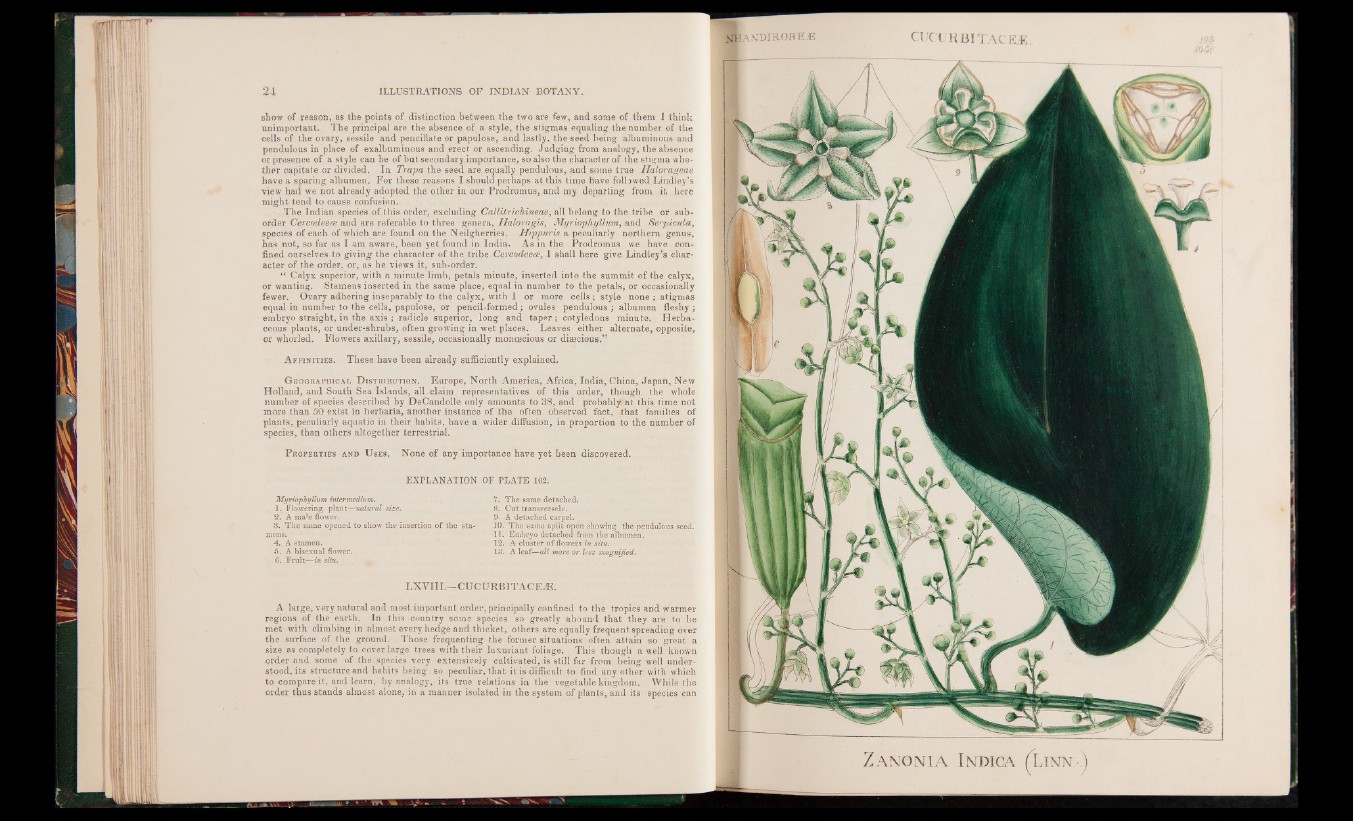
show of reason, as the points of distinction between the two are few, and some of them I think
unimportant. The principal are the absence of a style, the stigmas equaling the number of the
cells of the ovary, sessile and pencillate or papulose, and lastly, the seed being albuminous and
pendulous in place of exalbuminous and erect or ascending. Judging from analogy, the absence
or presence of a style can be of but secondary importance, so also the character of the stigma whether
capitate or divided. In Trapa the seed are equally pendulous, and some true Halorageae
have a sparing albumen. For these reasons I should perhaps at this time have followed Lindley’s
view had we not already adopted the other in our Prodromus, and my departing from, it here
might tend to cause confusion.
The Indian species of this order, excluding Callitrichineae, all belong to the tribe or suborder
Cercodeece and are referable to three genera, Haloragis, Myriophyllum, and Serpicula,
species of each of which are found on the Neilgherries. Hippuris a peculiarly northern genus,
has not, so far as I am aware, been yet found in India. As in the Prodromus we have confined
ourselves to giving the character of the tribe Cercodeece, 1 shall here give Lindley’s character
of the order, or, as he views it, sub-order.
** Calyx superior, with a minute limb, petals minute, inserted into the summit of the calyx,
or wanting. Stamens inserted in the same place, equal in number to the petals, or occasionally
fewer. Ovary adhering inseparably to the calyx, with 1 or more cells ; style none ; stigmas
equal in number to the cells, papulose, or pencil-formed; ovules pendulous ; albumen fleshy;
embryo straight, in the axis ; radicle superior, long and taper; cotyledons minute. Herbaceous
plants, or under-shrubs, often growing in wet places. Leaves either alternate, opposite,
or whorled. Flowers axillary, sessile, occasionally monoecious or diaecious.”
A f fin it ie s. These have been already sufficiently explained.
G eographical D istribution. Europe, North America, Africa, India, China, Japan, New
Holland, and South Sea Islands, all claim representatives oL this order, though the whole
number of species described by DeCandolle only amounts to 38, and probably at this time not
more than 50 exist in herbaria, another instance of The often observed fact, that families of
plants, peculiarly aquatic in their habits, have a wider diffusion, in proportion to the number of
species, than others altogether terrestrial.
P roperties and U ses. None of any importance have yet been discovered.
EXPLANATION OF PLATE 102.
MyriophyUum intermedium.
1. Flowering plant—natural size.
2. A ma'e flower.
3. The same opened to show the insertion of the stamens.
K '
4. A stamen.
5. A bisexual flower.
6. Fruit—in situ.
7. The same detached.
8. Cut transversely.
9. A detached Carpel.
10. The same split open showing the pendulous seed.
11. Embryo detached from the albumen.
12. A cluster of flowers in situ.
13. A leaf—all more or less magnified.
LXVIII.—CUCURBITACEÆ.
A large, very natural and most important order, principally confined to the tropics and warmer
regions of the earth. In this country some species so greatly abound that they are to be
met with climbing in almost every hedge and thicket, others are equally frequent spreading over
the surface of the ground. Those frequenting the former situations often attain so great a
size as completely to cover large trees with their luxuriant foliage. This though a well known
order and some of the species very extensively cultivated, is still far from being well understood,
its structure and habits being so peculiar, that it is difficult to find any other with which
to compare it, and learn, by analogy, its true relations in the vegetable kingdom. While the
order thus stands almost alone, in a manner isolated in the system of plants, and its species can
Zanonia Indica (Linn,.)